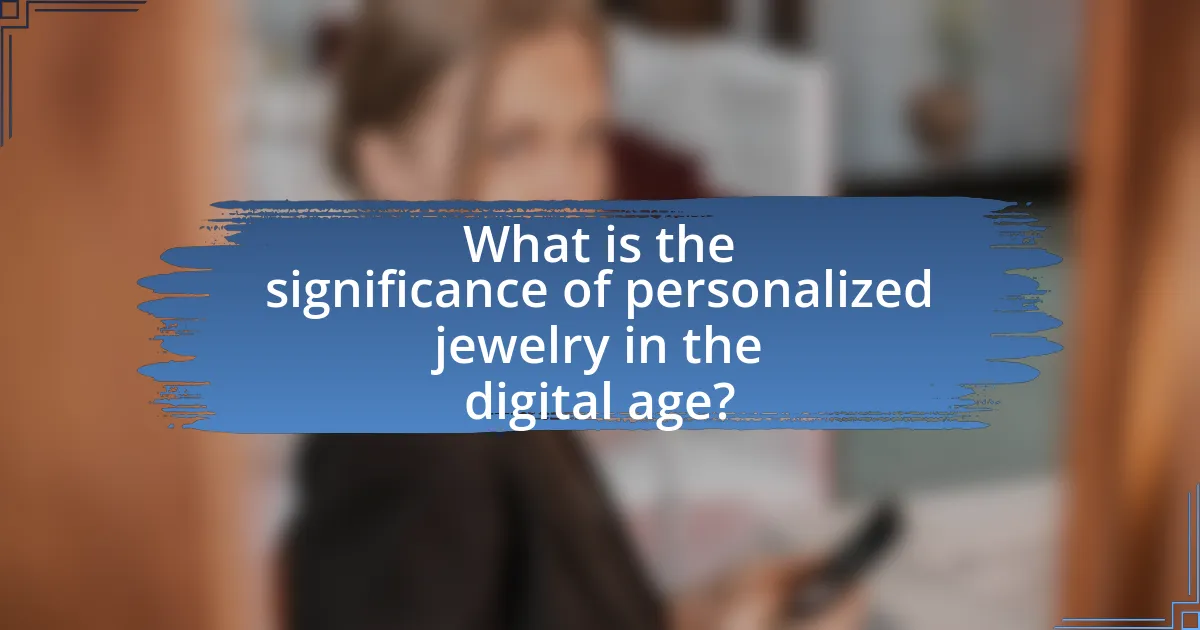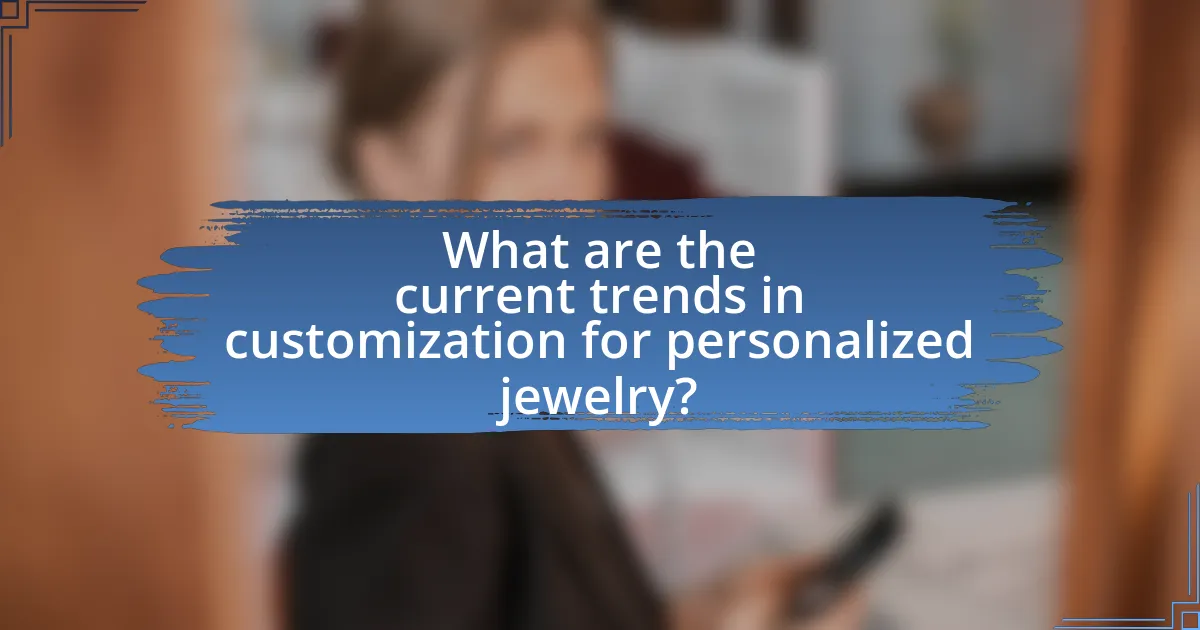The article focuses on the significant growth of personalized jewelry in the digital age, highlighting how advancements in technology, such as 3D printing and online customization tools, have transformed consumer preferences towards unique and meaningful designs. It discusses the emotional connections consumers seek through personalized pieces, the impact of social media and influencers on customization trends, and the increasing demand for sustainable practices in the jewelry industry. Additionally, the article outlines the challenges brands face in this market, effective marketing techniques, and best practices for consumers when purchasing personalized jewelry, emphasizing the importance of quality, authenticity, and clear communication.

What is the significance of personalized jewelry in the digital age?
Personalized jewelry holds significant value in the digital age as it allows individuals to express their unique identities and personal stories through customized designs. This trend is driven by advancements in technology, such as 3D printing and online customization tools, which enable consumers to create bespoke pieces that reflect their personal tastes and experiences. According to a report by Grand View Research, the global personalized jewelry market is expected to reach $40 billion by 2025, highlighting the growing consumer demand for individualized products. This shift towards personalization not only enhances emotional connections to jewelry but also aligns with broader consumer trends favoring authenticity and self-expression in a digital landscape.
How has technology influenced the growth of personalized jewelry?
Technology has significantly influenced the growth of personalized jewelry by enabling advanced customization options and streamlining production processes. Innovations such as 3D printing allow for intricate designs that can be tailored to individual preferences, while online platforms facilitate easy access to customization tools for consumers. According to a report by Grand View Research, the global personalized jewelry market is projected to reach $40 billion by 2025, driven by these technological advancements. Additionally, data analytics helps brands understand consumer trends, further enhancing the personalization experience.
What digital tools are available for customizing jewelry?
Digital tools available for customizing jewelry include CAD software, 3D modeling applications, and online design platforms. CAD software, such as RhinoGold and MatrixGold, allows jewelers to create precise designs and specifications for custom pieces. 3D modeling applications like Blender and Tinkercad enable users to visualize and manipulate designs in a virtual space. Online design platforms, such as Gemvision and CustomMade, provide user-friendly interfaces for customers to personalize jewelry by selecting materials, shapes, and engravings. These tools enhance the customization process, making it accessible and efficient for both designers and consumers.
How do online platforms enhance the personalization experience?
Online platforms enhance the personalization experience by utilizing advanced algorithms and user data to tailor recommendations and offerings to individual preferences. These platforms analyze user behavior, such as browsing history and purchase patterns, to create a customized shopping experience that resonates with each customer. For instance, a study by McKinsey & Company found that personalized recommendations can lead to a 10-30% increase in sales, demonstrating the effectiveness of targeted marketing strategies in enhancing user engagement and satisfaction.
Why is personalization important to consumers today?
Personalization is important to consumers today because it enhances their shopping experience by making products more relevant to their individual preferences and needs. Research indicates that 80% of consumers are more likely to make a purchase when brands offer personalized experiences, demonstrating a clear demand for tailored options. This trend is particularly evident in the jewelry market, where consumers seek unique pieces that reflect their identity and personal stories, driving the growth of personalized jewelry in the digital age.
What emotional connections do consumers seek through personalized jewelry?
Consumers seek emotional connections through personalized jewelry by desiring unique expressions of identity and sentiment. Personalized jewelry allows individuals to commemorate significant life events, such as anniversaries or births, thereby creating tangible reminders of cherished memories. According to a survey by The Knot, 80% of respondents indicated that personalized jewelry holds more emotional value than non-customized pieces, highlighting its role in fostering deeper connections to personal stories and relationships. This emotional significance is further reinforced by the ability to customize designs, engravings, or materials, making each piece a reflection of personal taste and experiences.
How does personalized jewelry reflect individual identity and style?
Personalized jewelry reflects individual identity and style by allowing individuals to express their unique preferences, values, and experiences through customized designs. This form of jewelry often incorporates personal elements such as initials, birthstones, or meaningful symbols, which serve as tangible representations of one’s personality and life story. According to a survey by the Jewelry Consumer Opinion Council, 70% of consumers prefer personalized items because they feel more connected to them, highlighting the emotional significance and individuality that personalized jewelry provides.

What are the current trends in customization for personalized jewelry?
Current trends in customization for personalized jewelry include the use of advanced technology such as 3D printing, which allows for intricate designs and unique shapes tailored to individual preferences. Additionally, consumers increasingly favor sustainable materials and ethical sourcing, reflecting a growing awareness of environmental impact. Custom engraving and the incorporation of birthstones or meaningful symbols are also popular, as they enhance personal significance. According to a report by Grand View Research, the personalized jewelry market is expected to grow significantly, driven by these customization trends and consumer demand for unique, meaningful pieces.
How are consumers engaging with customization options?
Consumers are increasingly engaging with customization options by actively participating in the design process of personalized jewelry. This trend is evidenced by a significant rise in online platforms that allow users to select materials, styles, and engravings, catering to individual preferences. According to a report by Grand View Research, the global personalized jewelry market is projected to reach $40 billion by 2025, indicating a growing demand for tailored products. Additionally, surveys show that 70% of consumers express a preference for unique items that reflect their personal identity, further highlighting the importance of customization in consumer behavior.
What popular materials and designs are trending in personalized jewelry?
Popular materials trending in personalized jewelry include sterling silver, gold, and stainless steel, while designs often feature initials, birthstones, and custom engravings. Sterling silver remains a favorite due to its affordability and versatility, while gold is sought after for its luxury appeal. Stainless steel is gaining traction for its durability and hypoallergenic properties. Designs that incorporate initials or names allow for personal expression, and the use of birthstones adds a unique touch, reflecting individual significance. The rise in demand for these materials and designs is supported by market trends indicating a growing consumer preference for personalized and meaningful jewelry options.
How do social media and influencers impact customization trends?
Social media and influencers significantly drive customization trends by creating a platform for personalized expression and showcasing unique products. Influencers leverage their reach to promote customized jewelry, often sharing their personal stories and experiences with these items, which resonates with their followers. For instance, a study by the Pew Research Center found that 72% of teenagers engage with influencers, leading to increased demand for personalized products that reflect individual identity. This trend is further supported by platforms like Instagram and TikTok, where visual content highlights the uniqueness of customized jewelry, encouraging consumers to seek out bespoke options that align with their personal style.
What role does sustainability play in personalized jewelry trends?
Sustainability plays a crucial role in personalized jewelry trends by driving consumer demand for ethically sourced materials and environmentally friendly production practices. As consumers become more environmentally conscious, they increasingly seek jewelry that reflects their values, leading to a rise in brands that offer sustainable options, such as recycled metals and lab-grown gemstones. According to a 2021 survey by McKinsey & Company, 67% of consumers consider sustainability when making a purchase, highlighting the importance of eco-friendly practices in the jewelry industry. This shift not only influences purchasing decisions but also encourages jewelers to adopt sustainable practices, thereby shaping the future of personalized jewelry.
How are brands incorporating eco-friendly practices in customization?
Brands are incorporating eco-friendly practices in customization by utilizing sustainable materials and ethical sourcing methods. For instance, many jewelry brands now offer options for recycled metals and ethically sourced gemstones, which significantly reduce environmental impact. According to a 2021 report by the Ethical Jewelry Council, 70% of consumers prefer brands that prioritize sustainability, indicating a strong market demand for eco-conscious customization. Additionally, brands are adopting eco-friendly packaging and minimizing waste through made-to-order models, which further supports their commitment to sustainability.
What consumer preferences are emerging regarding sustainable jewelry options?
Consumers are increasingly favoring sustainable jewelry options that prioritize ethical sourcing and environmentally friendly materials. This shift is driven by a growing awareness of the environmental impact of traditional jewelry production, with 66% of consumers indicating a preference for brands that demonstrate sustainability practices, according to a 2021 survey by McKinsey & Company. Additionally, there is a rising demand for transparency in the supply chain, as consumers seek assurance that their jewelry is made from recycled metals and conflict-free gemstones. This trend reflects a broader movement towards responsible consumption, where consumers are willing to pay a premium for products that align with their values.

What challenges do brands face in the personalized jewelry market?
Brands in the personalized jewelry market face several challenges, including high production costs, inventory management, and customer expectations for rapid delivery. High production costs arise from the need for specialized materials and craftsmanship, which can limit profit margins. Inventory management becomes complex due to the variety of customizable options, making it difficult to predict demand accurately. Additionally, customers increasingly expect quick turnaround times for personalized items, putting pressure on brands to streamline their production processes while maintaining quality. These challenges require brands to innovate in their operations and supply chain management to remain competitive in the growing market.
How do brands ensure quality in customized products?
Brands ensure quality in customized products by implementing rigorous quality control processes throughout the production cycle. This includes using high-quality materials, employing skilled artisans, and conducting thorough inspections at various stages of production. For instance, in the personalized jewelry sector, brands often source precious metals and gemstones from reputable suppliers to guarantee authenticity and durability. Additionally, many brands utilize customer feedback and advanced technology, such as 3D modeling, to refine designs and ensure that the final product meets customer specifications and expectations. This commitment to quality is evidenced by the fact that brands that prioritize quality control often see higher customer satisfaction rates and repeat business, which are critical in the competitive landscape of personalized jewelry.
What are the common pitfalls in the customization process?
Common pitfalls in the customization process include lack of clear communication, inadequate understanding of customer preferences, and overcomplication of designs. Clear communication is essential; without it, customers may receive products that do not meet their expectations. A study by Deloitte found that 36% of consumers feel brands do not understand their needs, leading to dissatisfaction. Additionally, failing to accurately capture customer preferences can result in designs that do not resonate with the target audience. Overcomplicating designs can also lead to production challenges and increased costs, ultimately affecting the overall customer experience.
How can brands effectively manage customer expectations?
Brands can effectively manage customer expectations by clearly communicating product details, timelines, and potential limitations. This involves setting realistic expectations through transparent marketing, providing accurate descriptions, and ensuring that customer service representatives are well-informed to address inquiries. For instance, a study by the Harvard Business Review found that companies that prioritize clear communication see a 20% increase in customer satisfaction. By consistently delivering on promises and proactively addressing any issues, brands can foster trust and enhance customer loyalty in the personalized jewelry market.
What strategies can brands adopt to succeed in the personalized jewelry market?
Brands can succeed in the personalized jewelry market by leveraging advanced customization technologies, enhancing customer engagement, and utilizing data analytics. Advanced customization technologies, such as 3D printing and augmented reality, allow customers to visualize and create unique designs, which increases satisfaction and loyalty. Enhancing customer engagement through social media platforms and interactive online experiences fosters a community around the brand, encouraging repeat purchases. Utilizing data analytics helps brands understand consumer preferences and trends, enabling them to tailor offerings effectively. According to a report by Grand View Research, the personalized jewelry market is expected to grow significantly, driven by consumer demand for unique and meaningful products, highlighting the importance of these strategies.
How can brands leverage customer feedback for improvement?
Brands can leverage customer feedback for improvement by systematically collecting, analyzing, and implementing insights from customer interactions. This process allows brands to identify specific areas for enhancement, such as product features, customer service, and overall user experience. For instance, a study by McKinsey & Company found that companies that actively seek and act on customer feedback can improve customer satisfaction by up to 20%. By utilizing tools like surveys, social media monitoring, and direct customer interviews, brands can gather actionable data that informs product development and marketing strategies, ultimately leading to increased customer loyalty and sales.
What marketing techniques are effective for promoting personalized jewelry?
Effective marketing techniques for promoting personalized jewelry include targeted social media advertising, influencer partnerships, and user-generated content campaigns. Targeted social media advertising allows brands to reach specific demographics interested in customization, increasing engagement and conversion rates. Influencer partnerships leverage the credibility and reach of popular figures to showcase personalized pieces, enhancing brand visibility and trust. User-generated content campaigns encourage customers to share their unique jewelry experiences, fostering community and authenticity, which can lead to increased sales. According to a study by the Digital Marketing Institute, 70% of consumers are more likely to make a purchase based on peer recommendations, highlighting the effectiveness of these techniques in driving consumer behavior.
What are the best practices for consumers when purchasing personalized jewelry?
Consumers should prioritize quality, authenticity, and clear communication when purchasing personalized jewelry. First, they should research the materials used, ensuring they are durable and ethically sourced, as high-quality materials enhance the longevity and value of the jewelry. Second, consumers must verify the reputation of the seller by checking reviews and ratings, which can indicate the reliability and craftsmanship of the products. Third, clear communication with the seller regarding customization options, timelines, and return policies is essential to avoid misunderstandings. According to a 2021 survey by the Jewelry Consumer Opinion Council, 78% of consumers reported that transparency in the customization process significantly influenced their purchasing decisions.
How can consumers ensure they choose the right customization options?
Consumers can ensure they choose the right customization options by thoroughly researching available choices and understanding their personal preferences. This involves evaluating materials, styles, and features that align with their individual tastes and needs. For instance, consumers can read reviews and compare products from various brands to identify which customization options are most popular and well-received. Additionally, utilizing online tools or virtual try-ons can help visualize how different options will look, enhancing decision-making. Studies indicate that informed consumers are more likely to be satisfied with their purchases, as they make choices based on comprehensive information rather than impulse.
What tips should consumers follow to avoid common mistakes in personalized jewelry purchases?
Consumers should ensure they thoroughly research the jeweler and their customization options to avoid common mistakes in personalized jewelry purchases. This includes checking reviews, verifying the jeweler’s credentials, and understanding the materials used in the jewelry. Additionally, consumers should clearly communicate their design ideas and specifications to avoid misinterpretations. It is also crucial to confirm sizing and fit, as personalized items often cannot be returned or exchanged. According to a survey by The Knot, 70% of consumers reported dissatisfaction with their custom jewelry due to sizing issues, highlighting the importance of accurate measurements.


